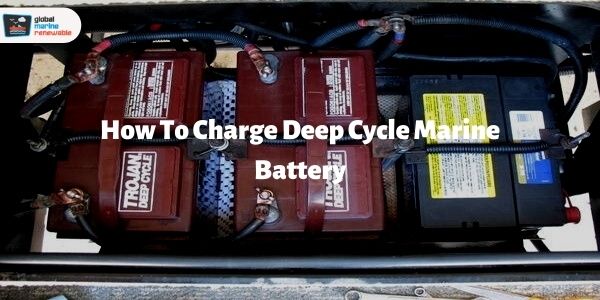Charging a deep cycle marine battery is a lot different than charging a regular car battery. Some sailboat operators learn how to check the health of a marine battery with the help of a Digital Multimeter.
Table of Contents
Easy Steps to Charge Deep Cycle Marine Battery
Knowing how to operate a Digital Multimeter is vital, but you must also consider a few more factors.
For instance, a 150 amp-hour deep cycle marine battery when hooked with a 2 amp charger would typically take 75 hours to charge. When the same process is carried out with a charger with higher current ratings, it will get charged quicker.
This post is intended to get you acquainted with the deep cycle charging process. Once you have the correct tools and equipment (discussed further) at hand, you can dive into the easy-to-follow steps to charge your deep cycle battery to 100 percent.
Related Guide: How long Does A Deep Cycle Marine Battery Last
What is a Deep Cycle Battery
The more you charge and discharge a deep cycle battery, the depth of discharge (DOD) will get reduced. Meaning, a deep cycle battery allowed to reach the lower limit (45 percent charge) regularly will get discharged faster.
A deep cycle battery is capable of smoothly operating until it is 80-85 percent discharge. Manufacturers do not recommend using a battery that has only a few amps of power left.
Ideally, you would want to recharge the battery when it reaches 50 percent discharge mark. Marine deep cycle batteries last longer when charged perpetually.
Here Are the 5 Easy Steps to Charge a Deep Cycle Marine Battery
Step 1: Clean the battery
The metal terminals of a deep cycle battery are always vulnerable to corrosion and rust. A corroded electrode lowers the battery charge time.
It also leads to the disintegration of the metal terminals. Hence, before charging a deep cycle marine battery, it is always good to clean the terminals with the help of a dry cloth. Make sure you wear latex gloves to protect the skin on your hands from acid discharge.
Step 2: Disconnect the deep cycle battery
If your battery is located in a cramped cockpit, it would be beneficial to move it to open space, before charging. First, disconnect the terminals and carry them to a dry place such as a deck.
Step 3: Uncover the battery
Before charging the battery, it is always right to check the electrolyte levels of each cell. To do this, you must uncover the battery and then pop-up the lid of each compartment.
Make sure you are still wearing the latex gloves as concentrated H2SO4 can have pH levels around 1.31–1.34.
Step 4: Measure the specific gravity or relative density of the water with a hydrometer
The state of the charge of a starter marine battery can be determined with the help of a Digital Multimeter.
However, to test the state of charge of a battery “cell,” you need to measure the electrolytes’ specific gravity (present inside a cell unit). A fluid with high specific gravity is dense and thick.
Similarly, in the case of H2SO4, the thicker the fluid, the higher the state of charge. The concentration of sulfuric acid in a fully charged deep cycle battery is 1.280.
Anything above 1.270 indicates the battery does not need more charging. You should charge the battery when the concentration of the H2SO4 drops below 1.140.
You can measure the specific gravity of H2SO4 present in a battery cell with a battery hydrometer. Simply draw a few drops of H2SO4 into the hydrometer tube and check the color of the fluid.
Brown color indicates the battery needs to be recharged. Use an electronic hydrometer to know the exact specific gravity value.
Step 5: Set the battery charger
Once you determine that the deep cycle marine battery needs charging, the next step would be to connect the battery terminals to a charger. Just a side note, some sailboat operators use a charger as a “maintainer.”
A maintainer keeps the battery charged at all times, so there is no chance of self-discharge or battery getting over drained.
Since you are interested in one-time charging, I suggest connecting the battery terminals to an external power source.
Connect the positive terminal of the battery to the positive terminal of the charger. Also, join the negative terminals of the battery and charger together. Now the battery is ready for charging, turn the charger on.
Easy Steps to Charge Deep Cycle Marine Battery Summary
For more deep cycle battery charging recommendations, I would suggest you check out this document from USBattery.
To know the correct charging time of a deep cycle marine battery, I would recommend reading the device nameplate or the instruction manual.
